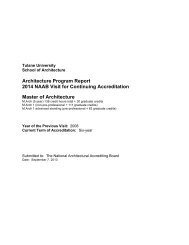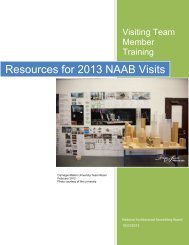Architecture Program Report Tulane University New Orleans ...
Architecture Program Report Tulane University New Orleans ...
Architecture Program Report Tulane University New Orleans ...
Create successful ePaper yourself
Turn your PDF publications into a flip-book with our unique Google optimized e-Paper software.
apidly and radically changed design and production methods in the practice of<br />
architecture. Even more fundamentally, that nature of architectural form and space has<br />
been altered given the new opportunities for new knowledge and creative thinking the<br />
use of these new technologies as they permeate architectural pedagogy and<br />
professional practice. <strong>Tulane</strong> School of <strong>Architecture</strong> is also grappling with the task of<br />
integrating the use of new technologies with the traditional curriculum of design<br />
education. As noted by the NAAB Visiting Team under the rubric "Representation," the<br />
School is deficient in incorporating the use of computers in the design studios, both<br />
physically and in terms of the curriculum, providing a necessary level of instruction for<br />
their use and extension into design thinking processes, and requiring a level of mastery<br />
by all students prior to graduation. Whereas only a decade ago, the School was<br />
graduating students with skills more typically advanced than found in the profession, the<br />
profession has now taken the lead in this respect, and the School of <strong>Architecture</strong>—not<br />
unlike its aspirant and peer institutions—is struggling to keep up with new innovations<br />
and applications.<br />
4. Graduate <strong>Program</strong>s<br />
While the undergraduate program in architecture (Masters of <strong>Architecture</strong>, 5 year<br />
program) and the Master of Preservation Studies <strong>Program</strong> are strong and competitive<br />
programs, the post-baccalaureate first-professional Masters of <strong>Architecture</strong> degree (3.5<br />
years) and the Post-professional programs are in need of the focus and development,<br />
necessary to attract high-quality students who wish to pursue advanced study and<br />
research. As the profession becomes increasingly complex and diverse, advance study<br />
has become necessary for professionals who seek to be innovators and leaders. These<br />
individuals are in search of thematically organized curricula that address specific issues<br />
or content areas, and are offered by Schools of national distinction. Currently, the School<br />
has neither the focus nor the resources to develop such programs. Additionally,<br />
distinctive graduate programs will beneficially affect the outcomes of the firstprofessional<br />
degree programs by diversifying the student body in attracting motivated,<br />
mature, skilled and research-oriented students. Under the new administration, however,<br />
this component of study and research is being developed by the Faculty, in consultation<br />
with the School's Curriculum Committee.<br />
5. National Distinction and Reputation<br />
The School of <strong>Architecture</strong> enjoys a solid reputation among those that have had<br />
personal or professional contact with our graduates or have in some way participated in<br />
the life of the School. However, the School does not have the prominence that it should,<br />
or could, at the national and international levels. This would help in attracting high quality<br />
students and distinguished faculty. This is, in part, an affect of our location—its distance<br />
from major metropolitan centers—but is also a result of not aggressively promoting the<br />
School or having the communications infrastructure necessary to do so. The new<br />
administration is moving aggressively to address this deficiency, and it is an overarching<br />
component of the new Strategic Plan.<br />
6. Faculty/Staff Salaries<br />
As both internal and external statistics demonstrate, the faculty and staff are significantly<br />
underpaid for the commitment and contributions they make to the School and <strong>University</strong>.<br />
Without some progress towards equitable compensation, morale will continue to decline,<br />
affecting both performance and outcome. This is particularly true with mid-career














